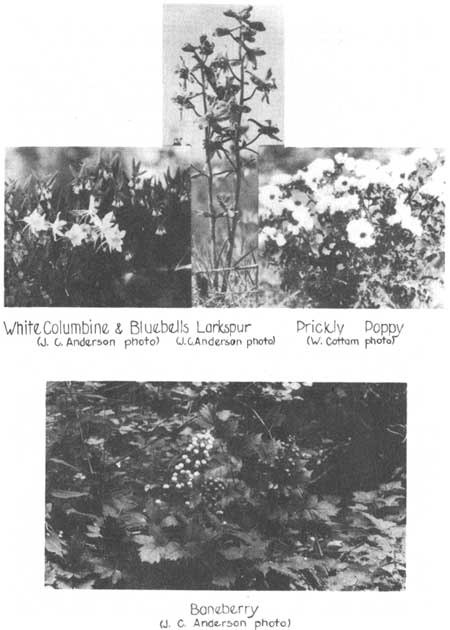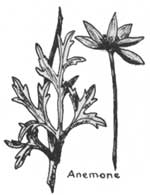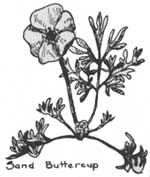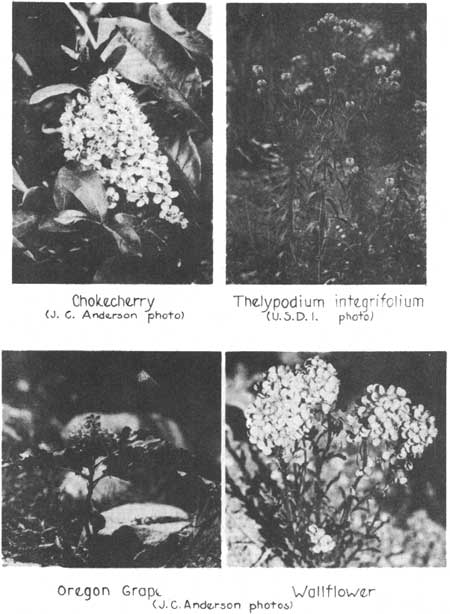|
ZION
Plants of Zion National Park |

|
Zion-Bryce Museum Bulletin
Number 1
PLANTS OF ZION NATIONAL PARK
Families of Plants
(continued)
GOOSEFOOT FAMILY (CHENOPODIACEAE)
Our representatives of this family are weedy, alkali-tolerant plants with inconspicuous greenish flowers. The one-seeded fruit has a loose, sometimes winged covering. Spinach and beets are members of this family.
PIGWEEDS have pale green opposite leaves, usually white-mealy beneath. There are three kinds in Zion: Chenopodium album, usually called "Lamb's Quarters", has wide sharply toothed leaves; C. incanum has shorter leaves, fewer toothed; and C. leptophyllum, has long narrow leaves.
SALTBUSH, Atriplex canescens. A silvery green, profusely branched shrub, 2 to 5 feet high, with conspicuous clusters (in late summer) of four-winged seeds the same color as the leaves. It is very common in dry areas of both Sonoran Zones. The male and female flowers usually grow on separate plants.
RUSSIAN THISTLE, Salsola pestifer. A common, troublesome weed introduced from Europe and familiar to nearly everyone. It is a round "tumble weed", with short spine-like leaves that turn red at maturity. It is being gradually eradicated from the park.
AMARANTH FAMILY (AMARANTHACEAE)
Many members of this family are troublesome weeds; some of then have been introduced. Only one species, a native, is found here — PIGWEED, Amaranthus blitoides.
FOUR-O'CLOCK FAMILY (NYCTAGINACEAE)
A well known family containing several garden flowers with beautiful blossoms. Our most showy native species is the FOUR-O'CLOCK, Quamoclidion multiflorum, which closely resembles its cultivated relative. It is a sturdy perennial, spreading its thick glossy dark green leaves low over the ground, and producing an abundance of funnel-shaped purple flowers in late May and June. It is most often found on slopes in the Sonoran Zones, and is abundant among the broken lavas along the highway between the park and Anderson's Ranch.
Two SAND VERBENAS grow in Zion, Abronia elliptica being the most common, in sandy places up to 7000 feet altitude, blooming from late May to early July. It is quite common at the east entrance. The flowers are greenish white or creamy, as are also those of Abronia salsa, which is found near alkali spots in Coalpits Wash, blooming in late April and May. In the latter species the fine hairs on stems and leaves are much more sticky than in the former.
Wedeliella incarnata is one of the least showy of this family. It is a prostrate much-branched perennial with fine sticky hairs on leaves and branches, and small pinkish white flowers appearing in June. Found in Coalpits Wash.
PURSLANE FAMILY (PORTULACACEAE)
Our representatives of this family are small plants having smooth, succulent leaves and small white or pink flowers with 5 very delicate petals.
SPRING BEAUTY, Claytonia rosea, often forms solid beds on moist banks in such cool retreats as Hidden and Refrigerator Canyons and The Narrows, in early June. Each plant has two narrow leaves near the base, about 3 inches long, above which are 4 or 5 practically leafless branches with a single flower at the top of each. The plants are rarely over 6 inches high.
Three kinds of MINER'S LETTUCE grow in the park. They all have numerous stems growing from a central base, and near the top of each stem are two leaves joined together to form a disc or cone surrounding the stem. The flowers are very small. Claytonia utahensis is the most common, in sandy soil between 4000 and 7000 feet elevation; Claytonia perfoliata grows in moist places on the plateaus and in cool canyons; and Claytonia parviflora depressa is found in moist places below 4000 feet, as at Coalpits Wash.
PINK FAMILY (SILENACEAE)
The 5 members of this family found in Zion are distinguished by their slender stems, slightly enlarged where the narrow opposite leaves are attached. The carnation belongs to this family.
CHICKWEED, Alsine jamesiana. A tall (2 feet) erect, slightly sticky chickweed with white star-like flowers, found on the plateaus and in cool canyons. Alsine longipes has been reported from Hidden Canyon.
SANDWORTS have extremely narrow, sharp-pointed leaves, often forming a dense cluster at the base of the plant. The loose clusters of a few flowers each are on erect, sparsely-leaved stems. There are two forms here: Arenaria macradenia, about 1 foot tall, white flowers, common in dry places below 7000 feet; and Arenaria nuttallii, 4 to 8 inches tall, on the plateaus.
COCKLE, Lychnis drummondii, has been collected on Horse Pasture Plateau.

PLATE IV
BUTTERCUP FAMILY (RANUNCULACEAE)
Within this large family are many plants differing widely in appearance, some of which are believed to be the most primitive seed-plants now living. To most visitors it is interesting because it contains many species that have beautiful flowers.
BANEBERRY, Actaea arguta. (Plate IV). A rank, coarse perennial, often 3 feet high. It has terminal clusters of small white flowers; the poisonous red berries, the size of a pea, ripen in July and August. Found in rich damp soil in the coolest canyons.
Three kinds of COLUMBINES occur in Zion, all easily recognized by their showy flowers which have 5 long nectar-bearing spurs. In the hanging gardens and moist places in all the canyons, especially in The Narrows and at Weeping Rock, two kinds are very common, blooming most profusely in June: the RED-SPURRED COLUMBINE, Aquilegia rubicunda, and the YELLOW COLUMBINE, Aquilegia thalic-trifolia. In a few cool forested ravines near Potato Hollow a very large white kind is sometimes found, growing up to 6 feet tall with flowers over 3 inches across and nectar spurs 2 inches long. It is named Aquilegia caerulea albiflora, a subspecies of the famous Colorado blue columbine, Although rare in Zion, it is abundant at high elevations around Cedar Breaks (Plate IV).

LARKSPURS are not very common in the park, except on the plateaus, where Delphinium menziesii, the LOW LARKSPUR, is found blooming in May and June. Delphinium bicolor (blue and white) has been collected in Zion, exact location unknown. In Coalpits Wash, and other low dry places, there is a pale blue form, Delphinium amabile, blooming in April and May (Plate IV).
The only ANEMONE in Zion, Anemone tuberosa, is found in Coalpits Wash.
VIRGIN'S BOWER or CLEMATIS is found widely scattered throughout the park, most often in chaparral where the vines, climbing over the bushes, form conspicuous light green bowers, bearing cream-colored little flowers in foamy clusters during most of the summer. There are two kinds: Clematis ligusticifolia, and a wider-leaved species, Clematis brevifolia.
ALPINE CLEMATIS, Clematis pseudoalpina. A low-growing semi-erect form with a large pale purple flower borne in the top of a drooping stem, On the plateaus and in cool canyons, blooming in June; not common.
BUTTERCUP, Ranunculus cymbalaria saximontana. Blooms in early June, in wet places such as the springs along the Narrows Trail.

SAND BUTTTERCUP, Beckwithia juniperina. One of the earliest blooming plants in the park, appearing from mid-February to April, in bare sandy places among the junipers in the Upper Sonoran Zone. The Great Arch Trail is perhaps the best place to see them.
MEADOW RUE, Thalictrum fendleri, A lacy much-branched perennial about 2 feet high with very small green flowers; sometimes mistaken for maiden-hair fern. Common in cool, moist places in canyons and on the plateaus.
BARBERRY FAMILY (BERBERIDACEAE)
This family is represented in the park by the familiar HOLLY-GRAPE or OREGON GRAPE, Odostemon repens, which grows sparingly throughout the park above 4000 feet. The yellow blossoms, blooming in May and June, are very attractive; and the purple berries were often used by the pioneers for making jelly. (Plate V). A taller, more prickly-leaved species, Odostemon fremontii, has been reported from Lower Sonoran areas within the park.

PLATE V